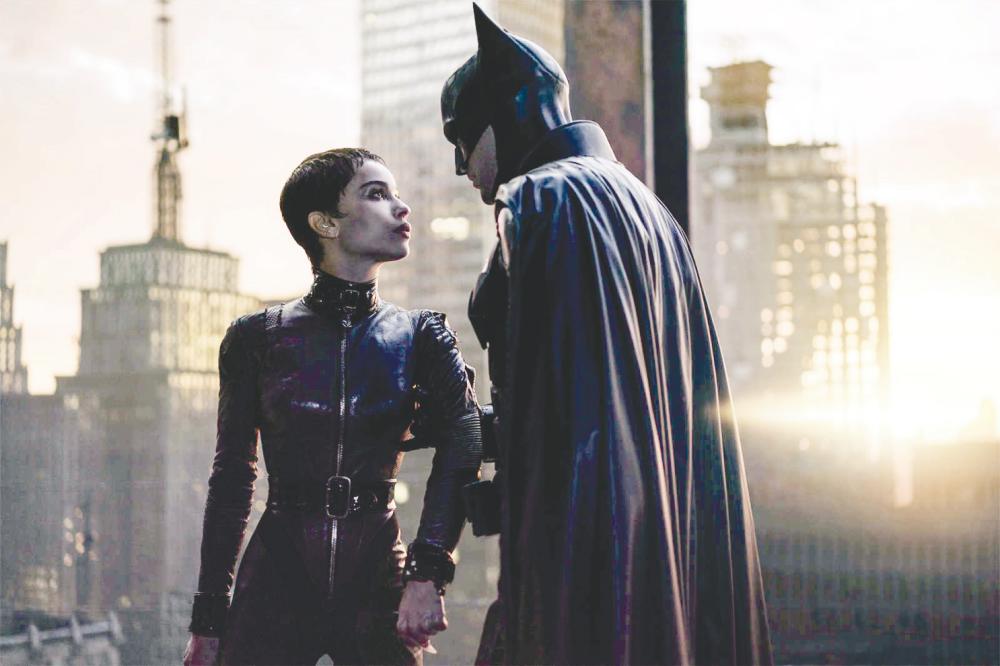WALKING in on his butler deciphering a coded message in the parlour of his gothic abode, Bruce Wayne cringes at the sunlight penetrating the ornate room.
The nocturnal crimefighter then slips on a pair of sunglasses indoors and begins eating a blueberry. The scene marks one of the few moments of levity in Warner Bros.’ The Batman.
Like story arcs in Batman’s Detective Comics series, The Batman is director Matt Reeves’ brutal, unforgiving film take on the Batman mythos told under the lens of the vigilante’s “World’s Greatest Detective” moniker.
Set two years into Bruce Wayne’s (Robert Pattinson) vigilante career as Batman, the caped crimefighter is faced with the daunting task of finding a serial killer calling himself The Riddler (Paul Dano), as both Gotham City and himself slowly come under siege from the revelations that are unearthed with each gruesome murder.

Laying the trilogy foundation
This blockbuster film is, ironically, what I call an “anti-blockbuster film”, because The Batman stands in complete opposition to what many would consider a mainstream superhero film.
Think of what a Marvel – or even other DC Comics – films are about. World-ending threats. Jokes. Huge action setpieces. Large spectacles.
These aren’t prevalent in The Batman, because the film, as a whole, is a subdued crime story about the underbelly of criminal organisations, and the festering, corrupting effects of crime on politicians and the armed forces, and how the neglected in society can its biggest threat.
Reeves has gone on record to cite The French Connection, All the President’s Men and Taxi Driver as influences on The Batman’s neo-noir detective story, among several others. I’ll also throw in Jean-Pierre Melville’s Le Samourai and David Fincher’s Seven.
The Batman is also a character study of Bruce Wayne and Batman (Robert Pattinson), and to a lesser extent, the film’s antagonist, The Riddler (Paul Dano).

The film is a lot of Batman walking around, and talking to people. It’s Bruce Wayne being in self-isolation, in deep thought, and having inner monologues.
It’s the behind-the-scenes of both personas investigating crime scenes, evidences and going through stacks of old files.
Under Reeves’ direction, Robert Pattinson shines more than he has in the indie films that the actor has been involved in the last decade.
Brooding, reclusive, and tormented by the weight of his self-imposed duty as Batman to fight crime in Bruce Wayne’s attempt to heal a dying, seemingly irredeemable city, Pattinson employs his body and eyes to act, contort, stretch and wretch in such a physical way that has never been seen in other actors that have portrayed Bruce Wayne/Batman.
Back when Christian Bale was under the cape and cowl during Christopher Nolan’s trilogy, Bale was very physical in his role. The pain and trauma of the character was conveyed by Bale’s physicality and voice.
With Pattinson, it’s the whole package.
Though its not really a question of “if”, but rather “when” Warner Bros. goes through with the trilogy idea, this role will very obviously be Pattinson’s career-defining role thus far.
Punctuating the detective work and character study, are the few action sequences in the film. These exist to break up the slow-burn detective work by Batman and James Gordon (Jeffrey Wright).
Each crescendo in the plot requires Batman to beat one or more persons into a pulp, and when these rare moments of brutality envelope the silver screen, they’re beautifully directed by Reeves and filmed by Greig Faiser.

Gotham, in its wet, grimy glory
Faiser, who was also the cinematographer of Zero Dark Thirty, Rogue One, Dune and The Mandalorian, marries colours, flashes of lights and the void of darkness to bring out every element within each frame of The Batman, and in action sequences, Faiser frames the shots tight, so that every emotion and strike is viscerally front and center, such as the only chase sequence with the Batmobile.
There hasn’t been a Batman film, or even a Gotham City that has been shot and lit the way Faiser has done with The Batman.
But what makes Gotham isn’t just the fact that it is a neon, nocturnal city that is perpetually assaulted by rainfall. No, Gotham is also Gotham because of its crime and the neverending amount of criminals that are birthed in its dark alleys.
In The Batman, supporting antagonists include Oswald ‘The Penguin’ Cobblepot (Colin Farrell) and Carmine Falcone (John Turturro).
Turtorro does a good job as a mob boss, but it is Farrell who, under tonnes of makeup, is explicitly amazing as Cobblepot. Forget the squawking of Danny DeVito’s Penguin.
It is something Warner Bros. realises, as the actor will be getting his own HBO Max spinoff series that focuses on The Penguin’s rise to power in the echelons of Gotham’s crime families.

Opposite Pattinson, stands Zoë Kravitz as Selina Kyle or Catwoman. Though several others have played Batman’s main squeeze in films over the last few decades, Kravitz makes a strong case as possibly the best and most developed Selina Kyle.
Also playing a role on Bruce Wayne’s side of moral alignment, Wright’s Gordon is also great to watch.
I found it interesting how he ends every conversation with Batman with “man”, as though the vigilante was any other person on the street.
Despite the two teases in the third act, The Batman’s sequels are better off not treading old ground. Be daring, Reeves, like you were when making this film different from previous Batman films. Bring in others from Batman’s diverse Rogue Gallery.
Avoid the dark Gotham alleys that mainstream audiences have seen, Warner Bros. Look above, at the shadowed perches, where the Court of Owls peers down at Gotham.









